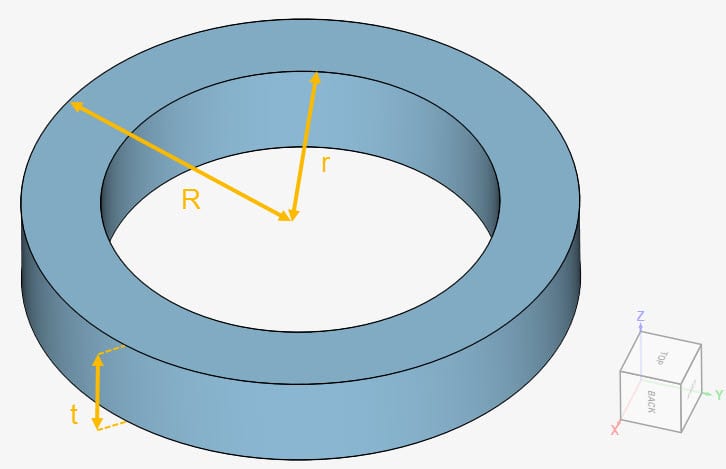Documentation
This validation case belongs to solid mechanics. In this case, an infinite cylinder is subjected to a voluminal load. The parameter being validated is:
SimScale simulation results were compared to the analytical solution presented in [SSLA100]\(^1\).
The geometry for this project consists of a slice of an annulus between two cylinders, as seen in Figure 1:

The dimensions of the geometry are given in Table 1:
| Geometry parameters | Dimension \([m]\) |
| Outer radius \((R)\) | 1.4 |
| Inner radius \((r)\) | 1 |
| Thickness of the slice \((t)\) | 0.5 |
Tool Type: Code_Aster
Analysis Type: Linear static
Mesh and Element Types: The mesh used in this case is a second-order mesh created in SimScale with the standard algorithm.
Table 2 contains details to the resulting mesh:
| Mesh Type | Nodes | Element Type |
| Second-order standard | 991445 | Standard |
Figure 2 shows the standard mesh used for this case:
Material:
Boundary Conditions:
The boundary conditions will be defined based on the following nomenclature:
Note
Since the volume load is in cylindrical coordinates\(^1\), it was necessary to convert it to Cartesian coordinates using trigonometric functions. The resulting input formulae are:
$$Load_x = (x^2+y^2)cos(atan2(y,x)) \tag {1}$$
$$Load_y = (x^2+y^2)sin(atan2(y,x)) \tag {2}$$
$$Load_z = 0 \tag {3}$$
In equations 1 and 2, the \((x^2+y^2)\) term represents radius squared. The second part of the equations, consisting of trigonometric functions, is responsible for the conversion from cylindrical to Cartesian coordinates. As a result, the loads will be applied in a radial direction.
The analytical solution for the displacements of the inner and outer wall are presented in [SSLA100]\(^1\). Find below a comparison between SimScale results and the analytical solution:
| Radius \([m]\) | Analytical displacement\(^1\) \([m]\) | Displacement – SimScale \([m]\) | Error [%] |
| 1 | 0.521309 | 0.521259 | -0.0096 |
| 1.4 | 0.442031 | 0.441986 | -0.0102 |
In Figure 5, we can see the resulting displacement contours. SimScale results show great agreement with the analytical solution.
Last updated: September 4th, 2023
We appreciate and value your feedback.
Sign up for SimScale
and start simulating now